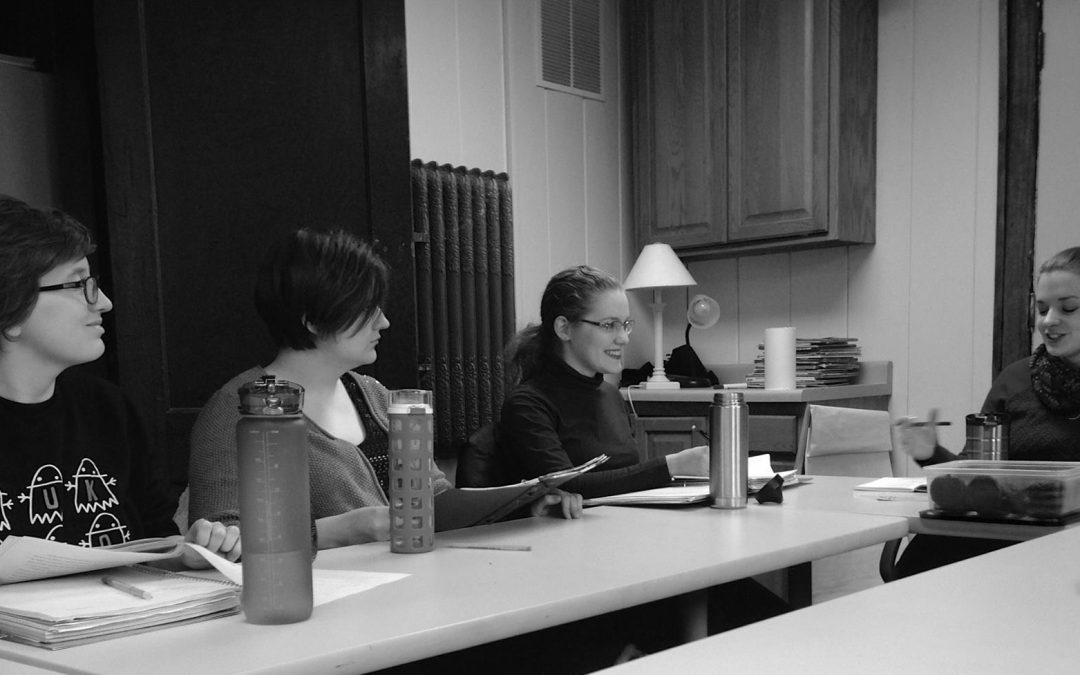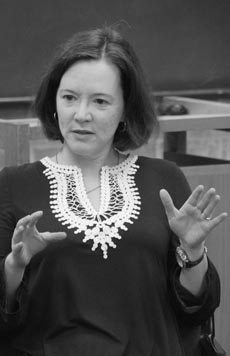The Runestone Creative Nonfiction editorial board was pleased to be given the task of transcribing and editing the interview with our visiting writer, Joni Tevis. The following are the thoughts and reflections of each member as they took Tevis’ spoken words and turned them into a written project.
Sophia Myerly:
For Joni Tevis, the research process is a creative act in and of itself.
Her process offers many insights and ideas for writers who seek to weave research into their own writing. During the interview, she explained that the act of taking notes in books can be a gift to one’s future self, and she encouraged us to cultivate a reading list that allows us to read broadly and bravely.
Some of Tevis’ more unusual research advice included visiting places that many would call ‘tourist traps,’ which, as her essays show, can lead to some wonderful and strange writing that braids many ideas together. To attain this cohesive structure, however, is a challenge—and Tevis shared one technique that she used for her essay, “What Looks Like Mad Disorder: The Sarah Winchester House.” This structure resembles a wheel, where the main subject is the hub, and the other topics or ideas that link to the main idea are the spokes of the wheel. This approach seems fitting as a way to organize ideas and get them rolling into an essay that transports the reader.
Belle Allan:
So inspired by Tevis’ work ethic in conducting research, I ventured into a place rarely explored: my university library.
This is not to say that students at Hamline do not read, but that the physical books within the library often go untouched. Nowadays, if a student wishes to research a topic, they turn first to our online database: Summon. Many texts can now be found online, and if one wishes to use an actual paper and cardboard book, it can be “summoned” online and picked up at the library’s front desk. In my three years at Hamline, I had never wandered through the stacks to find a real-life book.
Now, with a mission to pull whatever drew me, I weaved around the shelves on Bush Library’s third floor and pulled whatever caught my eye. I ended up with a comical stack of books on topics from social movements to film ethics. I plopped them on an empty desk and realized I had found a new hobby. I had before me a wealth of knowledge that pulled me in a million different directions. I can guarantee that I will be “Tevis-ing” in my library for the entirety of the summer.
Jake Kjos:
Tevis’ use of music in her essays shows not only through the references to Liberace and Buddy Holly, but with the shapes and rhythms that she carefully places her words. Tevis believes writers should mix up their writing routine and try different styles to keep their writing fresh.
This includes putting essays, poems, or stories into new and different shapes to guide both the piece and the reader. Perhaps the thing that characterizes Tevis best is her willingness to go to new places. No matter how exciting she believes a tour of an old house is going to be, getting out into the world provides great writing material and opens up numerous potential subjects for exploration. Some of the best work can come from getting out of your element and seeing how that affects your thought process.
Allie Pikala:
“How do we cultivate a habit of attention and awareness to the world around us?”
When asked about cultivating a writing “spark,” Joni shared a daily exercise she borrows from Lynda Barry’s, Syllabus. It consists of recording five things you saw, five things you heard, five things you did, and a picture from your day. What follows is my mini-version of this exercise with regards to the interview.
Things I saw:
Joni taking time to talk to each person who came up to get their book signed.Things I heard:
“Why not just write about things you really care about?”
“Bravery over perfection, every time.”
“You’ve got to take care of your body because it carries your brain around.”
“Give yourself permission to write what you need to write about.”Things I did:
Some stretches, lead by Joni. Listened in awe.A picture:
When she signed my book, she saw that I’d written my name on the inside cover. Joni Tevis drew a small heart next to it.
Meghan O’Brien:
During our interview with Joni Tevis, she quoted Ron Carlson, saying, “internet play has done more damage to writers than alcoholism ever will.”
I couldn’t agree more. It’s so easy to get sucked into Facebook, Twitter, Netflix, Pinterest, etc.; and no matter how good your intentions are initially, when you’re online you’re not writing.
Pinterest is my downfall. What started out as innocent fun perusing the site for funny e-cards and cute clothes turned into my vice. I now have 16 boards and an endless amount of time wasted.
If you find yourself constantly stuck for time, you should keep track of how often you’re online. Give yourself a small amount of time to look on your designated social media site only after you’ve done your work for the day. I haven’t been able to stick to it yet, but I know it all starts by closing my browser.
Before you close this browser, take a look at Runestone volume 2 and get inspired. Then, send us your work. Our submissions are open until the first of October for volume 3. Guidelines are here.
Thanks to the entire CNF editorial board:
Associate Editor, Hillary Walker; Assistant Editor, Sophia Myerly; and student editors, Belle Allan, Jake Kjos, Meghan O’Brien, and Allie Pikala.




